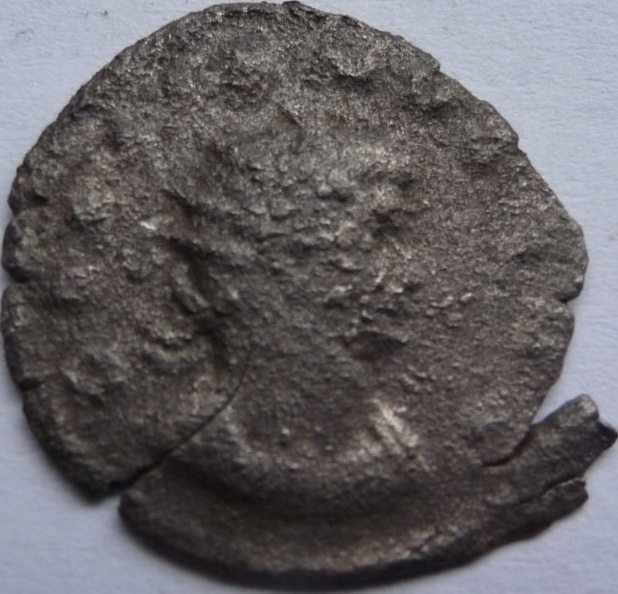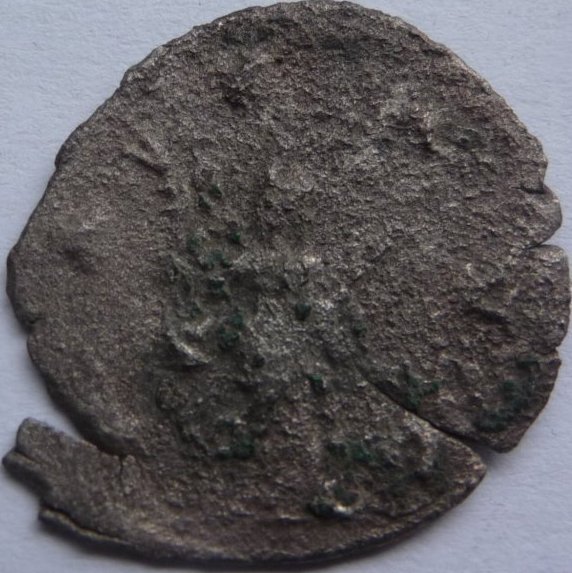|
Roma, 9.7.2024
Egregio,
di seguito riporto gli elementi significativi
riguardanti la moneta di figura:
Antoniniano1,
zecca di Roma, 260-268 d. C. 2, RIC V/I
256 (pag. 153), Cohen V
728 (pag. 413),
indice di frequenza "C".
Descrizione sommaria (sono indicate in rosso le parti
della leggenda usurate o comunque non più leggibili):
D. GALLIENVS AVG3.
Gallieno, busto radiato e corazzato a destra.
R. PAX AVG3. La
Pace, gradiente a sinistra, sorregge con la mano
destra un ramo d'ulivo e con la sinistra uno scettro.
V a
sinistra nel campo.
La ricerca nel web di monete della tipologia di figura
ha dato luogo ai seguenti risultati:
- https://www.vcoins.com/it/stores/sebastian_sondermann/150/product/gallienus_antoninianus__pax_avg__v__ric_256/259462/Default.aspx
€20.00 Quotazione: 07/08/24 Sebastian Sondermann
Ancient Coins Roman. Imperial Gordianus III to
Regalianus Gallienus Antoninianus - PAX AVG / V -
RIC 256 Gallienus Antoninianus, struck AD 260 -262
at Rome mint.Obv: GALLIENVS AVG, radiate head
right. Rev: PAX AVG / V (in left field), Pax
standing left, holding branch and transverse
spear. 4,27g, 20mm. RIC 256, Cunetio 963 heavy
flan.
- https://images.auex.de/img/19//176/01351Q00.jpg
Lot 1351 Gallienus (253 - 268 n. Chr.). Antoninian
(Silber). 253 - 268 n. Chr. Rom. Vs: GALLIENVS
AVG. Kopf mit Strahlenkrone rechts. Rs: PAX AVG,
im Feld links V. Pax mit Olivenzweig und Szepter
nach links stehend. 20mm. 3,97g. Lot 1351.
Gallienus (253 - 268 n. Chr.). Antoninian
(Silber). 253 - 268 n. Chr. Rom. Vs: GALLIENVS
AVG. Kopf mit Strahlenkrone rechts. Rs: PAX AVG,
im Feld links V. RIC 256 var. (Variante mit
Beizeichen V links im Feld nicht aufgeführt).
Reste von Silbersud unter dünner Oxidschicht, fast
vorzüglich. Result 20€, My Bid Estim. Price 15€.
Result 20€. My Bid Estim. Price 15€.
- https://leunumismatik.com/source/images/auction/33/02683q00.jpg
Lot 2683Gallienus, 253-268. Antoninianus (Silvered
bronze, 21mm, 4.00g, 6h), Rome, 260-261. GALLIENVS
AVG Radiate and cuirassed bust of Gallienus to
right. Rev. PAX AVG Pax standing front, head to
left, holding olive branch in her right hand and
transverse scepter in her left; in field to left,
V. Cohen 728. MIR 366x. RIC 256 var. (position of
officina mark). Thin flan crack, otherwise,
extremely fine. Starting price: 25 CHF. Hammer
price: 30 CHF. Number of bids:2 BidsClosing time:
18-Jul-22, 12:38:00 CEST.
- https://leunumismatik.com/source/images/auction/29/03164q00.jpg
Lot 3164 Gallienus, 253268. Antoninianus (Billon,
21mm, 2.93g, 4h), Rome, 260-261. GALLIENVS AVG
Radiate and cuirassed bust of Gallienus to right.
Rev. PAX AVG / V Pax standing front, head to left,
holding branch in her right hand and scepter in
her left. Cohen 728. MIR 367x. RIC 256. Rare.
Struck from a somewhat worn obverse die and with
minor porosity, otherwise, very fine. From the E.
Mensch & A. Bauer Collection of coins of
Gallienus. Starting price: 25 CHF. Hammer price:
25 CHF. Number of bids: 1 Bid.
- https://leunumismatik.com/source/images/auction/29/03163q00.jpg
Lot 3163Gallienus, 253-268. Antoninianus (Silvered
bronze, 20mm, 4.20g, 5h), Rome, 260-261. GALLIENVS
AVG Radiate and cuirassed bust of Gallienus to
right. Rev. PAX AVG / V Pax standing front, head
to left, holding branch in her right hand and
scepter in her left. Cohen 728. MIR 366x. RIC 256
var. (position of officina mark). Minor area of
corrosion on the reverse, otherwise, about
extremely fine. From the E. Mensch & A. Bauer
Collection of coins of Gallienus. Starting price:
50 CHF. Hammer price: 95 CHF. Number of bids: 2
Bids.
- https://www.numisbids.com/n.php?p=lot&sid=7449&lot=677
Nomos AG obolos 30 17 Dec 2023 Lot 677 Starting
price: 50CHF. Lot unsold. Gallienus, 253-268.
Antoninianus (Billon, 22mm, 3.94g, 6h), Rome,
260-261. GALLIENVS AVG Radiate and cuirassed bust
of Gallienus to right. Rev. PAX AVG Pax standing
left, holding branch in right hand and transverse
scepter in left. Cohen 728. MIR 351x. RIC 256 var.
(officina). Fully silvered. Good very fine.
- https://www.colleconline.com/en/items/138358/coin-ancient-b-roman-republicain-imperial-gallienus-antoninianus-ric-256v-pax
GALLIENUS Antoninianus, RIC 256v, Pax OBV:
GALLIENVS AVG, radiate head right. REV: PAX AVG,
Pax standing left, holding olive branch and
sceptre. Left field: V. 3.2g, 20mm. Minted at
Rome, AD 260-8. Collection: Empire in Decline
(Maximinus I to Carinus).
- https://www.ma-shops.com/zufahl/item.php?id=1538
Römisches Kaiserreich 254-268 Gallienus Antoninian
Rom PAX AVG Zepter Zweig Strahlenkrone Sole Reign
RIC 256 VF 24,00 EUR. Conservazione: VF Numero di
Catalogo: RIC V 256. Materiale: biglione. Peso:
3.97g Diametro: 24.00mm Römisches Kaiserreich.
Gallienus 253-268 Antoninian. 3,97g, 21-24mm.
Erhaltung: Sehr schön. Münzstätte: Rom. Vs:
GALLIENVS AVG. Büste mit Strahlenkrone nach
rechts. Rs: PAX AVG. Pax mit Zepter und Ölzweig
nach links stehend. Im Feld: V RIC V 256.
- https://www.portugalmoedas.com.pt/en/gallienus-253-268-ad/6605-gallienus-antoniniano-gallienvs-avg-pax-avg-260-268-dc-253-dc-a-268-dc-.html
Gallienvs - Antoninianus PAX AVG / GALLIENVS AVG
Antoninianus 22mm (3.36g) coinage attributed to
circa 260 - 268 A.D, of Rome the presente city in
Italy. Primary International References of Various
Catalogs: RIC 256; Goebl 0366, Sear , Dalheim
hoard 12076-12077, RSC, Cohen 728 (See please as
there are several variants). GALLIENVS AVG,
Radiate head right. PAX AVG, Pax standing left,
holding olive branch and scepter, V in left field.
PAX AVG - Pax is the personnification of peace,
and her name is even used today in allegorical
legends in many different languages to represent
the idea of peace or the blessing of peace. Modern
historians refer to the early imperial period from
the time of Augustus until Marcus Aurelius as the
PAX ROMANA, or the Roman Peace.
Gallienus - Roman Emperor:
253-268 A.D Gallienus "Publius Licinius Egnatius
Gallienus Augustus" Born 218AD Died September 268
(aged 50), also known as Gallien,[2] was Roman
Emperor with his father Valerian from 22 October
253 to spring 260 and alone from spring 260 to
September 268. He ruled during the Crisis of the
Third Century that nearly caused the collapse of
the empire. While he won a number of military
victories, he was unable to prevent the secession
of important provinces. His 15-year reign was the
longest since the 19-year rule of Caracalla. Born
into a wealthy and traditional senatorial family,
Gallienus was the son of Valerian and Mariniana.
Valerian became Emperor on 22 October 253 and had
the Roman senate elevate Gallienus to the ranks of
Caesar and Augustus. Valerian divided the empire
between him and his son, with Valerian ruling the
east and his son the west. Gallienus defeated the
usurper Ingenuus in 258 and destroyed an Alemanni
army at Mediolanum in 259. The defeat and capture
of Valerian at Edessa in 260 by the Sasanian
Empire threw the Roman Empire into the chaos of
civil war. Control of the whole empire passed to
Gallienus. He defeated the eastern usurpers
Macrianus Major Mussius Aemilianus in 261–262 but
failed to stop the formation of the breakaway
Gallic Empire under general Postumus. Aureolus,
another usurper, proclaimed himself emperor in
Mediolanum in 268 but was defeated outside the
city by Gallienus and besieged inside. While the
siege was ongoing, Gallienus was stabbed to death
by the officer Cecropius as part of a conspiracy.
- https://ak.cngcoins.com/level3.asp?CurPage=26&CurLot=850
Gallienus, AD 253-268. Antoninianus (BI; 18-20mm;
2.19g; 7h) Rome, 9th issue, 265-267. GALLIENVS
[AVG] Radiate bust of Gallienus to right. Rev.
PA[X AVG] Pax standing left, holding branch in
left hand, sceptre in right; in the field to left,
Δ. C.727; MIR 36, 603a (27 known); RIC V, I p.
153, 256. Ex Glendining, London 19 Feb 1986, 411
and from the M. Weder collection, Pratteln 1986.
Concludo osservando che le caratteristiche fisiche,
generali e di stile della moneta di figura si
confrontano con quelle dei conî d'epoca di pari
tipologia. Il valore venale della moneta nel presente
stato di conservazione è stimabile, a mio avviso, in
meno di 10,00€.
Un saluto cordiale.
Giulio De Florio
-------------------------------
Note:
(1) Antoniniano
(riconoscibile dalla corona radiata sulla testa
dell'imperatore). Riporto in tabella le
caratteristiche fisiche degli antoniniani di
Gallieno della tipologia in esame reperiti nel web
(v. link):
| Riferimenti |
Peso(g) |
Asse
di conio (ore) |
Diametro(mm) |
| Link1 |
4,27 |
- |
20 |
| Link2 |
3,97 |
- |
20 |
| Link3 |
4,00 |
6 |
21 |
| Link4 |
2,93 |
4 |
21 |
| Link5 |
4,20 |
5 |
20 |
| Link6 |
3,94 |
6 |
22 |
| Link7 |
3,2 |
- |
20 |
| Link8 |
3,97 |
- |
21-24 |
| Link9 |
3,36 |
- |
22 |
| Link10 |
2,19 |
7 |
20 |
Si evince dalla tabella che il peso della moneta di
figura (1,72g, 21mm) è inferiore a quello delle
monete dello stesso tipo reperite nel web.
(2) La moneta è annoverata dal
RIC tra quelle non datate. I più l'attribuiscono al
periodo in cui Gallieno resse l'impero da solo, dopo
la cattura del padre da parte dei Persiani (260),
quindi 260-268 (anno dell'assassinio di Gallieno).
(3) GALLIENVS
AVG (GALLIENVS AVGustus). Publio
Licinio Egnazio Gallieno Augusto, nato nel 218
d.C., morto nel settembre del 268 (all'età di 50
anni), noto anche come Gallieno, fu imperatore
romano con il padre Valeriano dal 22 ottobre 253
alla primavera del 260 e da solo dalla primavera del
260 al settembre del 268. Regnò durante la crisi del
III secolo che causò quasi il crollo dell'impero.
Pur riportando numerose vittorie militari, non
riuscì a impedire la secessione di importanti
province. Il suo regno di 15 anni fu il più lungo
dai 19 anni di Caracalla. Nato da una famiglia
senatoria ricca e tradizionale, Gallieno era figlio
di Valeriano e Mariniana. Valeriano divenne
imperatore il 22 ottobre 253 e fece in modo che il
Senato romano elevasse Gallieno al rango di Cesare e
poi di Augusto. Valeriano divise l'impero tra sé e
suo figlio: Valeriano governò l'est e suo figlio
l'ovest. Gallieno sconfisse l'usurpatore Ingenuus
nel 258 e distrusse un esercito di Alemanni a
Mediolanum nel 259. La sconfitta e la cattura di
Valeriano a Edessa nel 260 da parte dell'Impero
sasanide gettò l'Impero romano nel caos della guerra
civile. Il controllo dell'intero impero passò a
Gallieno. Egli sconfisse gli usurpatori orientali
Macrianus Major e Mussius Aemilianus nel 261-262, ma
non riuscì a fermare la formazione dell'Impero
Gallico separato sotto il generale Postumus.
Aureolo, un altro usurpatore, si proclamò imperatore
a Mediolanum nel 268, ma fu sconfitto da Gallieno
fuori città e assediato all'interno. Mentre
l'assedio era in corso, Gallieno fu pugnalato a
morte dall'ufficiale Cecropio nell'ambito di una
congiura..
(4) PAX AVG
(PAX AVGusti - la Pace di Augusto). Quello della
Pace è un tema ricorrente nella monetazione di
Gallieno. |

